
Sculpture is the branch of the visual arts that operates in three dimensions. Sculpture is the three-dimensional art work which is physically presented in the dimensions of height, width and depth. It is one of the plastic arts. Durable sculptural processes originally used carving and modelling, in stone, metal, ceramics, wood and other materials but, since Modernism, there has been almost complete freedom of materials and process. A wide variety of materials may be worked by removal such as carving, assembled by welding or modelling, or moulded or cast.
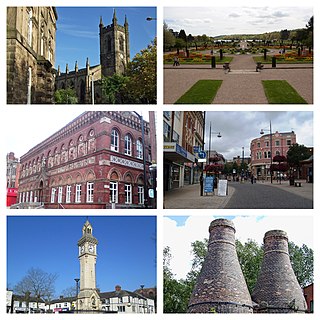
Stoke-on-Trent is a city and unitary authority area in Staffordshire, England, with an area of 36 square miles (93 km2). In 2021, the city had an estimated population of 258,400. It is the largest settlement in Staffordshire and is surrounded by the towns of Newcastle-under-Lyme, Alsager, Kidsgrove and Biddulph, which form a conurbation around the city.

African art describes the modern and historical paintings, sculptures, installations, and other visual culture from native or indigenous Africans and the African continent. The definition may also include the art of the African diasporas, such as: African-American, Caribbean or art in South American societies inspired by African traditions. Despite this diversity, there are unifying artistic themes present when considering the totality of the visual culture from the continent of Africa.
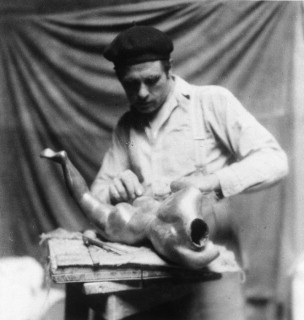
George Claude Leon Underwood was a British artist, although primarily known as a sculptor, printmaker and painter, he was also an influential teacher and promotor of African art. His travels in Mexico and West Africa had a substantial influence on his art, particularly on the representation of the human figure in his sculptures and paintings. Underwood is best known for his sculptures cast in bronze, carvings in marble, stone and wood and his drawings. His lifetime's work includes a wide range of media and activities, with an expressive and technical mastery. Underwood did not hold modernism and abstraction in art in high regard and this led to critics often ignoring his work until the 1960s when he came to be viewed as an important figure in the development of modern sculpture in Britain.
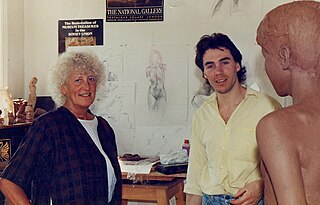
Dame Elisabeth Jean Frink was an English sculptor and printmaker. Her Times obituary noted the three essential themes in her work as "the nature of Man; the 'horseness' of horses; and the divine in human form".
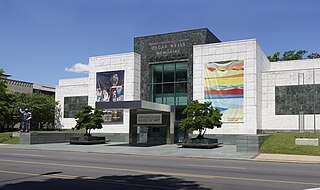
The Birmingham Museum of Art is a museum in Birmingham, Alabama. Its collection includes more than 24,000 paintings, sculptures, prints, drawings, and decorative arts representing various cultures, including Asian, European, American, African, Pre-Columbian, and Native American. The museum is also home to some Renaissance and Baroque paintings, sculptures,and decorative arts from the late 13th century to c. 1750.

Mintons was a major company in Staffordshire pottery, "Europe's leading ceramic factory during the Victorian era", an independent business from 1793 to 1968. It was a leader in ceramic design, working in a number of different ceramic bodies, decorative techniques, and "a glorious pot-pourri of styles - Rococo shapes with Oriental motifs, Classical shapes with Medieval designs and Art Nouveau borders were among the many wonderful concoctions". As well as pottery vessels and sculptures, the firm was a leading manufacturer of tiles and other architectural ceramics, producing work for both the Houses of Parliament and United States Capitol.

Most African sculpture was historically in wood and other organic materials that have not survived from earlier than at most a few centuries ago; older pottery figures are found from a number of areas. Masks are important elements in the art of many peoples, along with human figures, often highly stylized. There is a vast variety of styles, often varying within the same context of origin depending on the use of the object, but wide regional trends are apparent; sculpture is most common among "groups of settled cultivators in the areas drained by the Niger and Congo rivers" in West Africa. Direct images of African deities are relatively infrequent, but masks in particular are or were often made for traditional African religious ceremonies; today many are made for tourists as "airport art". African masks were an influence on European Modernist art, which was inspired by their lack of concern for naturalistic depiction.
Harry Everington was a British sculptor, the co-founder of the former Frink School of Figurative Sculpture based in the towns of Stoke-on-Trent, Staffordshire.
Lynn Russell Chadwick, was an English sculptor and artist. Much of his work is semi-abstract sculpture in bronze or steel. His work is in the collections of MoMA in New York, the Tate in London and the Centre Georges Pompidou in Paris.

Steven Whyte is a sculptor classically trained in the traditional methodology of figurative bronze and portrait sculpture living in Carmel, California. He has produced many public memorials and installations in both England and throughout the United States with subjects ranging from miners, to soldiers and fire fighters. He is credited with over fifty life size and larger bronze public figures and major monuments including The Silverdale Mining Memorial, The Lance Sergeant Jack Baskeyfield VC Tribute, The Spirit of 1948, and The Dr. John Roberts Monument. Whyte's multimillion-dollar, sixteen-figure monument in San Diego, California entitled National Salute to Bob Hope and the Military is one of his most notable works.

Laurence Broderick, MRBS FRSA, is a British sculptor. His best known work is 'The Bull', a public sculpture erected in 2003 at the Bull Ring, Birmingham. The Bull is about 4.5 meters long, about 220 cm high and weighs about 6.5 tons. It is one of the largest bronze animal sculptures in the country. His work consists largely of figurative carvings in stone and editions in bronze.
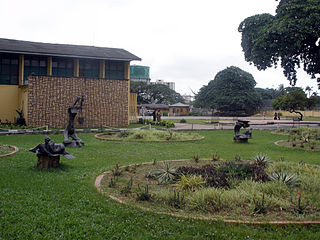
The Nigerian National Museum is a national museum of Nigeria, located in the city of Lagos. The museum has a notable collection of Nigerian art, including pieces of statuary, carvings also archaeological and ethnographic exhibits. Of note is a terracotta human head known as the Jemaa Head, part of the Nok culture. The piece is named after Jema'a, the village where it was discovered. The museum is located at Onikan, Lagos Island, Lagos State. The museum is administered by the National Commission for Museums and Monuments.
Reginald George Haggar (1905–1988) R.I., A.R.C.A., F.R.S.A. was a British ceramic designer. He was born in Ipswich and studied at Ipswich School of Art and the Royal College of Art. In 1929, he became assistant designer at Mintons pottery in Stoke-on-Trent, rising to art director six months later, a post he held until 1939. Working in water colours and ceramics, his designs reflected both the radical and lyrical elements of the Art Deco style.

Glenys Barton is a sculptor working mainly in ceramic and bronze.
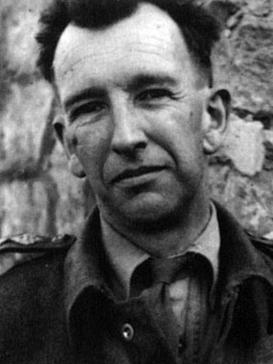
Blair Rowlands Hughes-Stanton was a major figure in the English wood-engraving revival in the twentieth century. He was the son of the artist Sir Herbert Hughes-Stanton. He exhibited with the Society of Wood Engravers, but was more in sympathy with the philosophy of the English Wood Engraving Society, of which he was a founding member in 1925. He co-directed the Gregynog Press from 1930 to 1933 with his wife, Gertrude Hermes.
Gray's Pottery, also spelled as Grays Pottery and formally known as A.E. Gray Ltd. was a British pottery company based in Hanley, Staffordshire, later Stoke-upon-Trent, which existed until it was taken over by Portmeirion Pottery in 1960.

Ralph Brown was an English sculptor who came to national prominence in the late 1950s with his large-scale bronze Meat Porters, commissioned for Harlow New Town, Essex and is known for his sensual, figurative sculptures.
Christine Gregory was a British sculptor and potter. She was among the first women elected as a member of the Royal Society of British Sculptors.
Ernest Arthur GardnerMAFSA known as Arthur Gardner, was an English writer, art historian and photographer with a particular focus on medieval sculpture and architecture.














